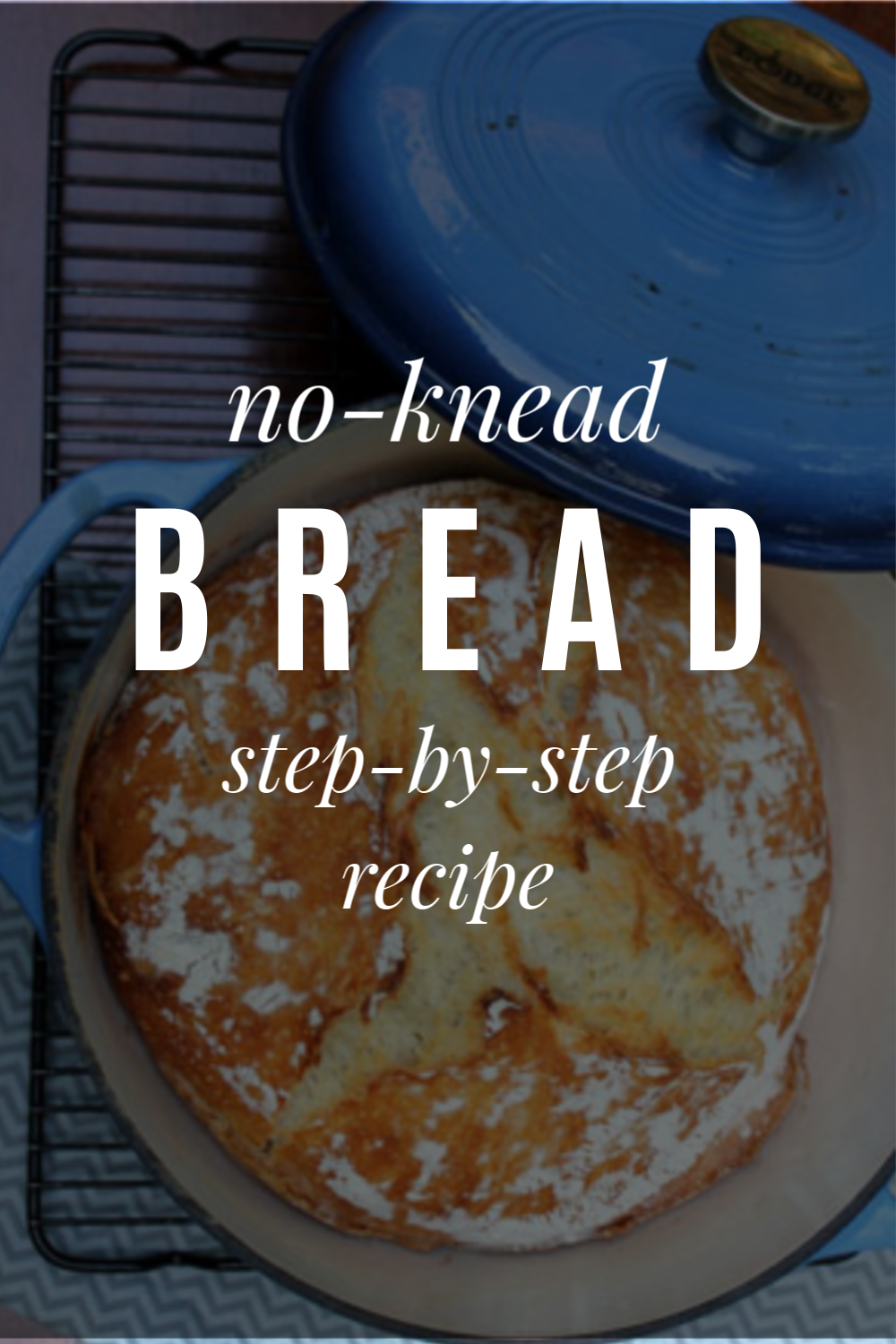
No-Knead Bread Recipe
If you have been hanging out around Frugal Living NW for awhile, you know that I am a big believer in making food from scratch at home. With a few exceptions, I prefer creating something in my own kitchen to buying it in the grocery store.
Bread can be tricky, though. There is some stiff competition out there, and it is tough to replicate a commercial oven’s heat and steam in a normal home kitchen.
For the last several years, I thought that Artisan Bread in 5 Minutes was the best thing since, well, sliced bread. It was simple, and we were content with the results. That is, until last summer when our neighbor brought over a beautiful, delicious loaf of home-baked bread. We had to know her secret. One phone call, and she came back with the book, My Bread by Jim Lahey (Amazon).
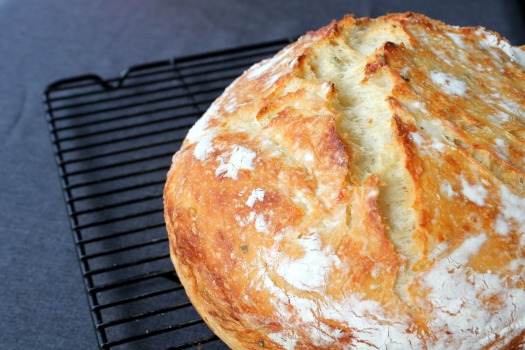
We have been baking bread using this method ever since. I can count on one hand the number of times I have bought bread in the store since then, because I can now make an artisan-quality loaf at home for a fraction of the cost.
I am telling you, this is consistently the best bread I have ever made in my kitchen. Okay, enough gushing. Let’s make some bread.
The only changes I have made to Lahey’s method is to double the amounts and adjust the baking time and temperature to achieve a bigger loaf with a thinner crust.
Oh, and don’t be put off by all these steps. This is totally possible for home bakers at any skill level. I wanted to give you the confidence to do this on your own. A concise recipe can be found at the bottom of this post.
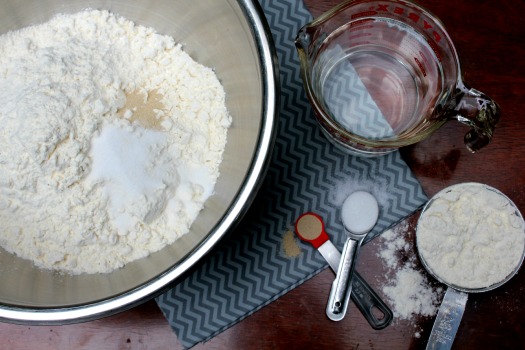
The ingredients are simple: flour, water, salt, and yeast. My husband calculated this bread costs 74¢ per loaf (using Bob’s Red Mill flour & Costco yeast).
Oh, wait! Don’t forget to factor in the roughly 8 cents of energy used to bake it for an hour. No, I’m serious. My husband really does think about this stuff! He’s funny.
So, there you go. A whopping 81¢ for a substantial 2.5 pound loaf of bread. That is crazy cheap.
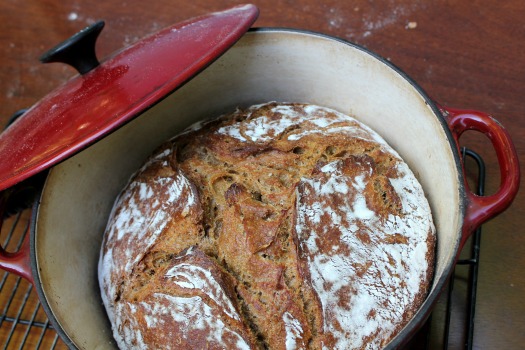
If you want to use some whole wheat flour, substitute 3 cups of whole wheat for 3 cups of the all-purpose flour (3 cups whole wheat and 3 cups of unbleached flour for a total of 6 cups) and add 3 Tablespoons of molasses (optional). This will produce a slightly sweeter, denser loaf of bread. Delicious.
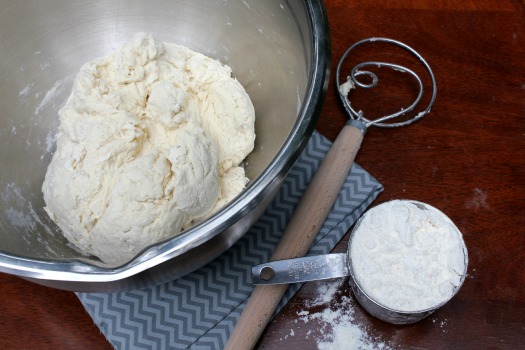
Combine the dry ingredients, add the water, and stir to combine (the funky looking wood-handled item is the amazing Danish Dough Wisk — makes stirring stiff dough a snap). The dough should be wet and sticky. Depending on the temperature and humidity in your home, you may need to add a little more flour or water, 1 Tablespoon at a time. So far, these steps are exactly the same as the 5 Minute method.
The main differences are that you use significantly less yeast (1/2 teaspoon vs. 1 1/2 Tablespoons) and significantly more initial rise time (12-18 hours vs. 2 hours).
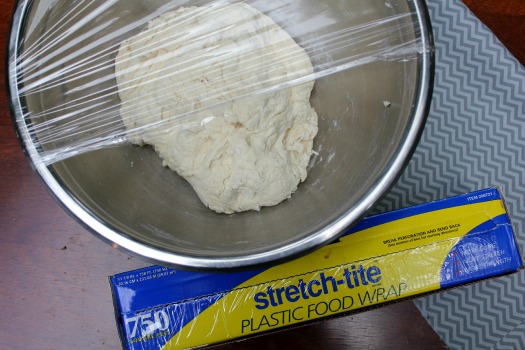
Once the ingredients are completely combined, cover the bowl with plastic wrap and leave it on the counter to rise for 12-18 hours. This slow rise aids in the fermentation of the yeast, giving the bread a better flavor.
Okay, I know what some of you are thinking: 12-18 hours! That’s ridiculous! Who has that kind of time?! I get it.
However, here are two things to consider:
- Once you get into a rhythm of baking your own bread, it’s not a big deal. I start mine in the afternoon or evening and bake it the next morning or afternoon. This would also be an easy weekend routine.
- Just like the title claims, this bread requires no kneading. It is not fussy, temperamental dough. You can produce a delicious loaf of bread with very little hands-on effort & experience.
You’ll know your dough is ready when it has risen in the bowl, smells yeasty, darkened slightly, and is covered with small bubbles.
Using well floured hands, shape and tuck the sticky dough into a rough ball. You can also fold it over a couple times on a well-floured surface. It doesn’t have to be perfect; just keep quickly tucking the dough underneath with your fingertips until you have a semi-smooth dough ball. The dough should be wet but manageable; you don’t want a wet blob so sticky that you can’t shape it into a ball.
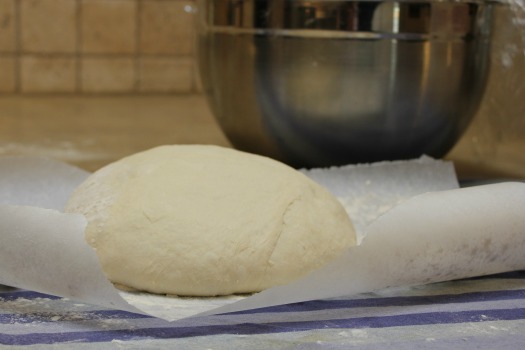
Take a clean linen or cotton tea towel (not terry cloth) and dust it with flour, cornmeal, or wheat germ to prevent the dough from sticking to the towel as it rises. You can also use a floured square of parchment paper on the towel to make the dough ball easier to handle. Place the dough ball, seam side down, in the middle and dust with more flour.
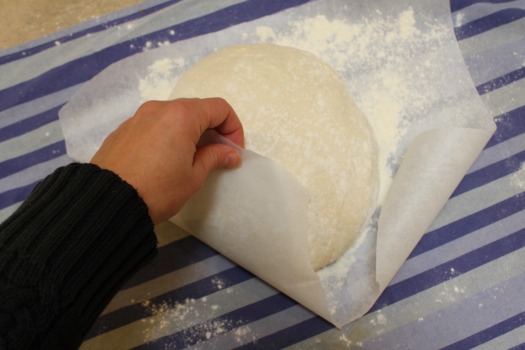
Cover the dough with the (parchment paper and) towel and let it rise for 1-2 hours at room temperature, until doubled in size. During the last 30 minutes of rise time, place a heavy lidded 6-8 quart pot, like a Dutch oven, in a cold oven and preheat it to 425 degrees.
Confession: I own three Dutch Ovens. I use them all the time. They are incredibly versatile and worth the investment. If you don’t own one, you could also make this in any lidded pot, provided it is oven-safe at such high temperatures. Also, check the knob on your pot. If it isn’t rated for such high heat, you’ll want to remove it or cover it with foil. You can also buy an inexpensive replacement knob that is rated for higher temps!
Okay, this is the trickiest part of the entire operation. Remove the lid from the piping hot Dutch Oven, slide your hand underneath the towel or parchment paper, and flip the risen dough (seam side up now) into the pot. Try to flip close to the pot or the flour will fly everywhere. Remove the towel or paper and set aside.
This might take a bit of practice, but again it doesn’t have to be perfect. Some of my worst flips have produced my most beautiful loaves. I love what Lahey writes, “…even the loaves that aren’t what you’d regard as perfect are way better than fine.”
Place the lid back on top and slide the pot back into the hot oven.
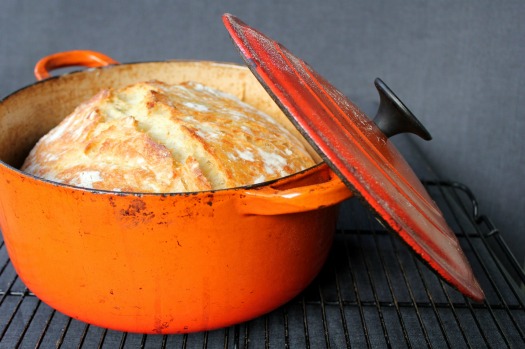
Bake it for 40-50 minutes. Remove the lid. Bake for another 5-10 minutes, until golden chestnut brown. The internal temperature should be around 200 degrees. You can check this with a meat thermometer if you’re nervous about knowing when your loaf is done.
Oh man, your house will smell so good about right now.
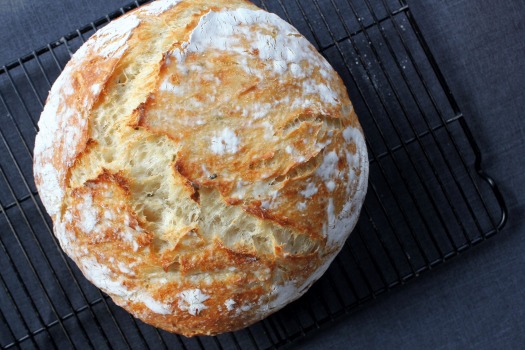
Place the loaf on a cooling rack. You will hear it crackling as it cools. Use every ounce of self-control to resist cutting into it until it is “quiet”; cutting it too soon will make the bread dense and gummy.
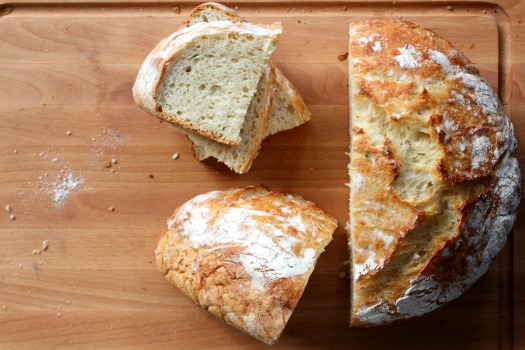
This bread is best the first 2-3 days. I just store my leftover loaf inside the Dutch oven on the countertop. Using plastic wrap will soften the crust. Dry, leftover bread makes great bread crumbs, toast, French toast, or croutons!
Enjoy. And pat yourself on the back. You just baked an amazing loaf of bread!
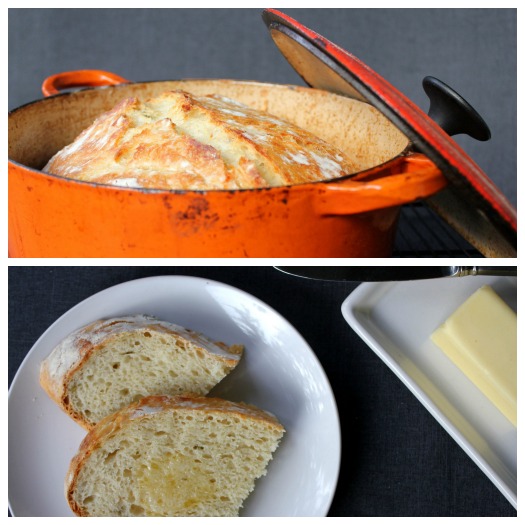
Basic No-Knead Bread
Slightly adapted from Jim Lahey’s My Bread
Ingredients
6 cups bread flour (recommended) or all-purpose flour, plus more for work surface
1/2 t. instant or active-dry yeast
2 1/2 t. salt
2 2/3 c. cool water
- In a large bowl, combine the flour, yeast, and salt. Add the water and stir until all the ingredients are well incorporated; the dough should be wet and sticky. Cover the bowl with plastic wrap. Let the dough rest 12-18 hours on the counter at room temperature. When surface of the risen dough has darkened slightly, smells yeasty, and is dotted with bubbles, it is ready.
- Lightly flour your hands and a work surface. Place dough on work surface and sprinkle with more flour. Fold the dough over on itself once or twice and, using floured fingers, tuck the dough underneath to form a rough ball.
- Place a full sheet/large rectangle of parchment paper on a cotton towel and dust it with enough flour, cornmeal, or wheat bran to prevent the dough from sticking to the parchment paper as it rises; place dough seam side down on the parchment paper and dust with more flour, cornmeal, or wheat bran. Pull the corners of parchment paper around the loaf, wrapping it completely. Do the same with the towel. Let rise for about 2 hours, until it has doubled in size.
- After about 1 1/2 hours, preheat oven to 425 degrees. Place a 6-8 quart heavy covered pot, such as a cast-iron Dutch oven, in the oven as it heats. When the dough has fully risen, carefully remove pot from oven. Unwrap the towel and parchment paper from around the dough and slide your hand under the bottom of the dough ball; flip the dough over into pot, seam side up. Pull the parchment paper off, scraping any stuck dough into the pan. Shake pan once or twice if dough looks unevenly distributed; it will straighten out as it bakes.
- Cover and bake for 40 minutes. Uncover and continue baking for 10-15 more minutes, until the crust is a deep chestnut brown. The internal temperature of the bread should be around 200 degrees. You can check this with a meat thermometer, if desired.
- Remove the bread from the pot and let it cool completely on a wire rack before slicing.
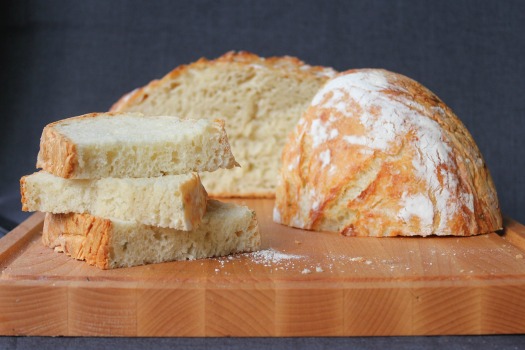
Here are a couple options for Dutch Ovens. Any heavy, lidded 5-8 quart pot (seasoned cast iron or enamel coated) would work with this recipe. Lodge has the best prices/options for dutch ovens on Amazon.
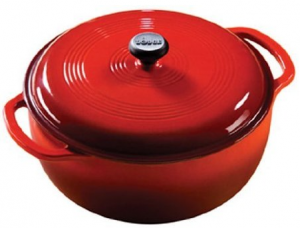
Lodge Logic Dutch Oven in Island Spice Red (6 Quart)
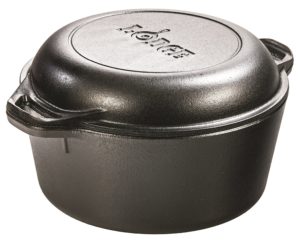
Lodge Cast Iron Double Dutch Oven (5 Quart)
If you already have a dutch oven (or find a deal on a lesser-known brand) that doesn’t have a knob rated for high temps, replace it! There are some really affordable options.
Got questions? You are in good company. Go here for the complete FAQ list.
Looking for more variations to the no-knead bread recipe? We’ve created a list with sweet and savory varieties, including the following:
- Cranberry Orange
- Four Cheese
- Sandwich Bread
- Dark Chocolate Coconut
- Tomato Basil Cheese
- Whole Wheat
Looking for more delicious bread recipes?
Find more delicious recipes on our Recipe Page!
Follow Frugal Living NW on Pinterest!
Fantastic range of boards from best recipes and tips for frugal living to gardening and budgeting help.
This post may contain affiliate links. See the disclosure policy for more information.
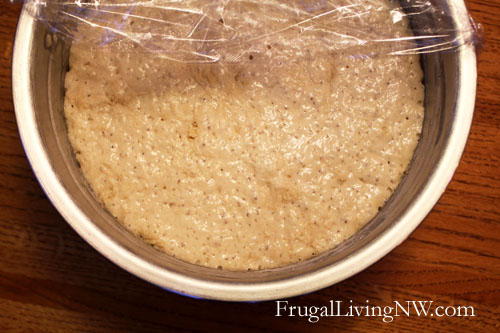
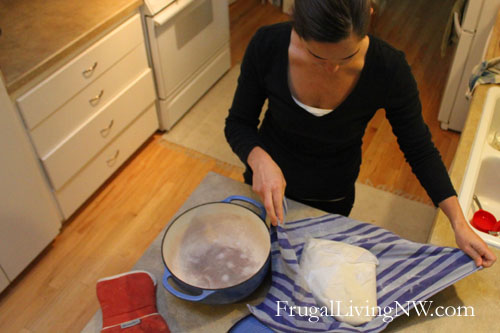
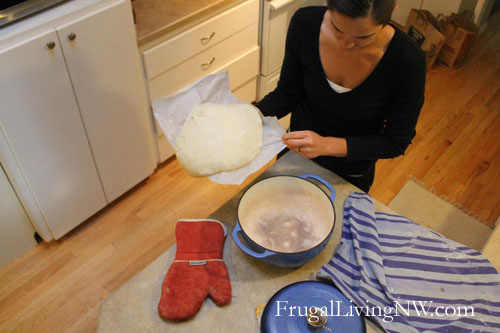

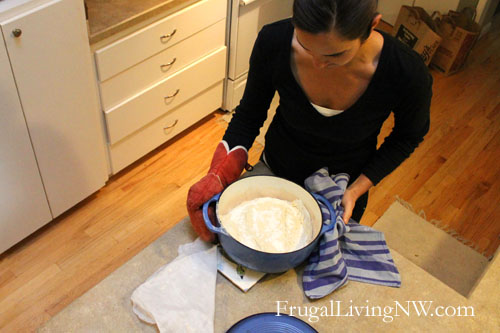
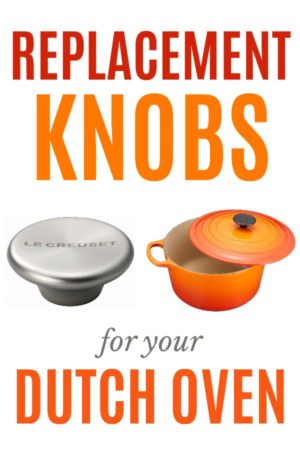

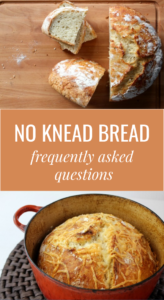
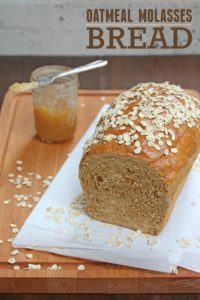
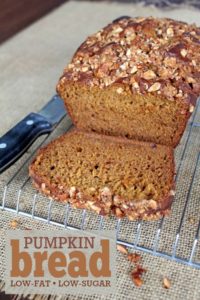
Wow. I found you on Pinterest and I started the bread last night and baked it today. I used 100% whole wheat (freshly ground in my mill), 1/3 C gluten and 3 T molasses as you suggested. My one problem was I didn’t dust my towel enough and the bread stuck and I thought I would have a flat, hard, rock of a loaf after baking, but it turned out great. I even took the dough that had stuck to my cloth and threw it on top and it still puffed up and baked wonderfully. I didn’t have a round pot, but an oval caste iron and it baked like a charm. Thank you for this unique and tasty recipe. This is our new favorite bread for when we have soups, grilled cheese, etc. My daughters are already saying they may enter it in the fair.
Wow. I found you on Pinterest and I started the bread last night and baked it today. I used 100% whole wheat (freshly ground in my mill), 1/3 C gluten and 3 T molasses as you suggested. My one problem was I didn’t dust my towel enough and the bread stuck and I thought I would have a flat, hard, rock of a loaf after baking, but it turned out great. I even even took the dough that had stuck to my cloth and threw it on top and it still puffed up and baked wonderfully. I didn’t have a round pot, but an oval caste iron and it baked like a charm. Thank you for this unique and tasty recipe. This is our new favorite bread for when we have soups, grilled cheese, etc. My daughters are already saying they may enter it in the fair.
Well, it is in the oven, but I had the same problem as some other fellow bakers…. it was too wet and running away.
I used 3 cups of rye whole grain and 3 cups of wheat whole grain flower. It seems that I should use more flower next time?
Also, the instructions ask for 3 cups of whole grain flower. Does that mean I should use 3 cups of white flower and 3 cups of wheat flower?
Might post an update later, as it just rang to remove the lit.
This is a great recipe, and so simple! I made it even simpler by omitting a step. I use King Arthur Flour organic unbleached bread flour. I also bake it in the Lodge cast iron 5 quart Dutch oven. I often make two loaves at a time. I mix the ingredients in my Kitchenaid until it forms a ball around the dough hook. I store it in a Pyrexr four quart glass bowl with lid for two days. I then plop it out on a floured surface and flip it once and quickly tuck the ends under. I don’t spend much time on it, I only want to give it a coating of flour so it is not sticky and I place it in my dutch oven. At that point I put it right in the oven and let it sit in there for 2 hrs. to rise at 150 degrees.When the timer goes off, I bump up the temp to 425 degrees for the 40 minute cook time, and take the lid off and cook another 10-15 minutes
I would love to know if there is a gluten-free version too!
Here’s an option, that I haven’t personally tried. http://glutenfreegirl.com/i-am-stubborn-i-dont-give-up/
Anyone else?
Ok- I’ve tried it twice and both times it has come out VERY dense. . . . almost gooey inside. My teenage boys still devour it, but it isn’t exactly what I was hoping for. I have never gotten the bread to the first stage of bubbles and darkening, even after 24 hours on the counter. Any suggestions??
Wow…the bread looks beautiful!! and so simple!! I LOVE IT! Some of us in our family have had to go “gluten-free”. Any chance you have the no-knead recipe in a gluten-free version?
Thanks again! Beautifully done post!
I would love to know if there is a gluten-free version too!
Thanks for this amazing recipe! It has worked like a charm for me and the bread is delicious. I have never felt so empowered to bake bread. I think I’m going to call this “gateway” bread since it has inspired me to try other recipes. I do recommend using the wax paper instead of the flour-coated tea towel for the second rise and the flip. For some reason when I tried a tea towel the dough really got stuck, even though I covered the towel copiously with flour beforehand. It’s not easy washing raw dough out of fabric, as I’ve now discovered.
Hi! Thanks for the recipe!
How do you think this could be modified with oat or coconut flours? In my early experiments with other recipes, I’ve found you need to add a lot more liquid. I have not been able to perfect this, though, and am hoping that someone has some suggestions?
I have a few cups of each leftover from a previous recipe and thought they may be incoporated here. Thanks!
Wondering about the temp while it is on the cabinet – thinking making it while camping and how warm is too warm for it to set out overnight. We only use the fireplace in the winter for heat, and its not uncommon for it to never get above 60 degrees in their. How temperamental is this going to be? Can’t wait to try it!
Hi,
I have been searching all over the Internet for an artisan recipe that
Can be made with whole wheat. Have u tried this recipe of
Yours with whole wheat? The recipes i found are just to dense. they dont have the chewey texture or air pockets. Maybe do half white half wheat? I also
Am wanting to make loaf artisan. I love the simple dump into Dutch oven
But would like loaf bread for sandwiches. How can I go about that?
I’ve never made this recipe with 100% whole wheat, though I know others have. I usually do 50/50 with whole wheat and white flours to give it a slightly lighter texure. Whole wheat bread is dense so you might have to pick what you want – whole wheat or air pockets.
I use this bread for sandwiches, toast, whatever. You could easily cut the recipe in half, shape it into 1-2 loaves and baked it in a loaf pan. It won’t have the same exact qualities as this rustic-style artisan bread, but it’ll still be a delicious loaf of bread!
This is the best bread ever!!! I make it at least twice a week and now add garlic,rosemary and herbs de Provence to it every time. DELISH
It looks great, but my husband mentioned it smells like home-made playdough. Now I can’t stop thinking that when I eat it. I made the wheat version and only used all purpose flour. I wonder if bread flour would make a difference in the playdough smell taste? Or maybe I didn’t bake it long enough? I’ll try a new one this week and see.
I enjoyed the no-knead bread recipe so much, especially the crust, I tweaked it into rolls.
For the final rising, I cut the dough into 16 balls and pre-heated stoneware bowls instead of a dutch oven.
Baked dough in the bowls for 20 min at 425°.
It took two batches, but the rolls were easy to lift from the bowls when they were done. (Careful, they’re hot!)
My family loves this bread!! Thank you so much for the recipe we are making it about twice a week, love it so easy. Can you add other ingredients to it like shredded cheese for different flavors or would it ruin the recipe? Thank you!
Yes! Check out our FAQ’s for some add-in ingredient ideas, including cheese. http://www.frugallivingnw.com/frugal-homemaking/no-knead-bread-answers-to-faqs/
Mix any add-ins into your dry ingredients (flour, salt, yeast), stir to combine, add water and proceed as written.
I made this a couple Weeks ago and it turned out delicious! I do not own a Dutch oven so I baked it in corningware with a lid and it turned out beautifully. I also have mini bowls so I literally used scissors to cut the dough and made bread bowls. They were awesome! Thought I would share if anyone else wanted to do the same:-)
FANTASTIC!! Just like the bakery. My friends loved it. Will be a staple from now on.
I am about to make this bread, but with a husband who eats bread like its going out of style, I was wondering if you can freeze these loaves after they are baked? Or should I just make a new one each time we run out?
Nevermind, i just read the FAQ’s
I cannot wait to try this! And glad I found your site. I love having fresh baked bread around, but a baker I am not…so you may have just made my day! Thanks!
Glad you found us, Leslie. You can totally do this. Let us know how your first loaf turns out!
Hi! Thank you SO MUCH for posting this… I’ve never made bread before and now I am TOTALLY HOOKED! My hubby was so proud.
I do have a question or need your advice, rather. Have you made different flavors using this recipe? Any tips on how to do that? Spices, cheesy bread, etc. Thanks again!!
I’m so happy you are hooked on baking bread from scratch!! Check out the FAQ’s for some add-in ideas. http://www.frugallivingnw.com/frugal-homemaking/no-knead-bread-answers-to-faqs/ You could really add any combination that floats your boat!
Add any extra ingredients to the dry ingredients (flour, salt, yeast) and stir to combine. Then add the water and proceed as written.
Happy baking!
Great tip storing the bread in the dutch oven. I’ve been making no knead bread for years, and this is prob the best tip I’ve learned. Makes total sense to store it in the pot it was baked in!
I’ve tried to extract the recipe from this explanation but cannot fully do so. I do not see the recipe at the bottom of the post. If you can, please let me know what it is. I would love to try it! Thanks!
6 cups bread flour (recommended) or all-purpose flour, plus more for work surface
1/2 t. instant or active-dry yeast
2 1/2 t. salt
2 2/3 c. cool water
In a large bowl, combine the flour, yeast, and salt. Add the water and stir until all the ingredients are well incorporated; the dough should be wet and sticky. Cover the bowl with plastic wrap. Let the dough rest 12-18 hours on the counter at room temperature. When surface of the risen dough has darkened slightly, smells yeasty, and is dotted with bubbles, it is ready.
Lightly flour your hands and a work surface. Place dough on work surface and sprinkle with more flour. Fold the dough over on itself once or twice and, using floured fingers, tuck the dough underneath to form a rough ball.
Generously dust a cotton towel (not terry cloth) with enough flour, cornmeal, or wheat bran to prevent the dough from sticking to the towel as it rises; place dough seam side down on the towel and dust with more flour, cornmeal, or wheat bran. Cover with the edges or a second cotton towel and let rise for about 2 hours, until it has doubled in size.
After about 1 1/2 hours, preheat oven to 425 degrees. Place a 6-8 quart heavy covered pot, such as a cast-iron Dutch oven, in the oven as it heats. When the dough has fully risen, carefully remove pot from oven. Remove top towel from dough and slide your hand under the bottom towel; flip the dough over into pot, seam side up. Shake pan once or twice if dough looks unevenly distributed; it will straighten out as it bakes.
Cover and bake for 40 minutes. Uncover and continue baking for 10-15 more minutes, until the crust is a deep chestnut brown. The internal temperature of the bread should be around 200 degrees. You can check this with a meat thermometer, if desired.
Remove the bread from the pot and let it cool completely on a wire rack before slicing.
Would it be possible to use glass loaf pans instead of the dutch oven?
thanks!
You would need to cover the loaf pans – although putting a pan of water in the oven might have the same results (pre-heat pan, pour in water after placing bread on rack, immediately close door) – but the glass part is not problem. I halve the recipe and use a covered Pyrex casserole, reducing the heat to 380. Turns out just like the pictures.
Great, thanks for the information, Jann!
What is the secret to the crust? I mean, what part of the recipe/instructions is responsible for creating the wonderful crust I see in the pictures? Our bread (following this same recipe) has not turned out nice and crusty like that in all of our tries.
Hi, Luisa- Do you bake it in a heavy lidded pot? The pot traps the steam from the dough, resulting in a nice, crisp crust.
Thanks for the reply! Yes, we got a Lodge Logic Dutch oven (non-enamel) and follow all the instructions. The bread tastes great—but seeing the great crust on the pictures here make our attempts look like ‘duds’ by comparison. We’ll keep on trying!
I was just about to buy one of the lodge Dutch ovens and would prefer to get one of pretty glazed ones but in the info it states that the lid handle is only oven save to 400 degrees. Has this been a problem for anyone?
Hi, Brooke – I cover my Lodge handle with foil just to be safe. You can also buy replacement knobs that look much better: http://www.frugallivingnw.com/online-deals/dutch-oven-replacement-knobs/
Hello I’ve made this bread a few times and love adding things to it. I haven’t quite figured out cinnamon raisin yet. I was wondering what other bread add ins have been done.
I’ve made this bread a few times and love adding things to it. I haven’t quite figured out cinnamon raisin yet. I was wondering what other bread add ins have been done.
I have added fresh grated parmesan cheese and dried dill and it was delicious!
I make a version of this bread that has slightly different ingredient amounts, but should be close enough that the add-ins would still work out fine. Here’s our favorites so far:
Feta and fresh rosemary
Blue Cheese and Caramelized Onion
Cinnamon Raison (need to add a little sugar)
I’m also planning to try a cheddar jalapeno at some point. And after reading Nancy’s suggestion, will also be trying the parmesan dill.
I used my soup pot, and right now, its taking all I’ve got to wait for it to cool to enjoy
Could you use a stoneware baking bowl with a lid to make this bread? Looks Delish! I’m excited to try it.
Hi Julie! I am almost positive people have left comments reporting success using covered stoneware dishes. I would just double check that it is rated for such high heat.
I absolutely love this recipe! I found a used clay cooking pot with a lid at a thrift shop. Pampered Chef has a no knead recipe on their website that explains how to use a clay pot. However the recipe on this site is so much easier to make so use this one!
I have a smaller Le Creuset – is it possible to halve the recipe to make a smaller loaf? I feel like sometimes when I bake, halving or doubling doesn’t work well. Thoughts? Thanks!
I did half a few days ago and it turned out fine. Lid on apx 30 and then off last 10 or so. I only wished I had a smaller Le Creuset so it would have been fuller – less flat. So, that is now on my shopping list!
Hi, Laura – Wanted to let you know that I make half the recipe like this: I put a cake pan inside my Dutch oven, cover it and preheat it. Then I plop the dough into the ungreased cake pan which is in the Dutch oven and bake. It comes out with nice sides and a high, round top. My cake pan is a “real” cake pan,
2-1/2 inches high and 7 inches in diameter. (David Lebovitz did a whole riff on “real” cake pans!) The Dutch oven is 6 inches high and 10 inches in diameter. I hope this helps you – it sure helped me – too bad it took me forever to think of it.
I have been wanting to learn to make my own bread for awhile and finally convinced myself to spend the $80 on a dutch oven to try out this recipe I picked up some flour and yeast on the way home and was finally going to give it a try.
I picked up some flour and yeast on the way home and was finally going to give it a try.
Well I realized when I got home I picked up Bob Redmills “Whole Wheat Pastry Flour” instead of bread flour. I have never used pastry flour before, in fact I have never even heard of it. Do you know if this will work with pastry flour?
I tried this recipe, it is wonderful!!! My hubby loves it and it stays fresh a long time, longer than my usual homemade bread does.
It is great toasted, or just with butter.
I love the crust, it is exactly what I like in bread, a bit tough but very tasty and lots of crunch.
I have tried “sour dough” bread before, this one is the easiest of all.
Just had to tell you how much we like this bread and hope to see lots of different recipes that I will use here as I go thru the site and glean info from it. Thanks for the recipe!!!
I have used your recipes a couple of times and have loved it. I recently prepared it using a levain or wild yeast. LOVE IT!
Hi!
I have my dough rising right now. I just had a question. I had to use a lot more than 2 2/3 c water to hydrate the 6 cups of flour. Comparing photos of my dough and the pictures, I have double the amount. I followed the recipe (for whole wheat molasses). So I used the written amount of yeast and salt. Is this alright? Did anyone had problems hydrating 6c of flour with the written amount of water for recipe?
Hi, Paula! This dough is slightly different every time I mix it together. The heat and humidity of your home, the flour you use, and the way you measure your ingredients can all affect the moisture level of the dough. Simply add water as needed to create a wet, but manageable dough. See the FAQ’s for more. Hope that helps!
I use about an extra 2/3cup water every time I make this (4th time today)
So I got a new glazed Dutch oven and the loaf stuck to it like a kid to his mother in a barber shop. I didn’t see anything about greasing the Dutch oven. Help?
Did you preheat the Dutch oven along with your oven? The pot is so hot that it sears the bottom of the bread when you dump it in. I have made about a dozen loaves and have never once had it stick. Try the parchment paper method.
I pre-heated it with the oven, starting cold then to 425. Maybe I should let it heat up uncovered?
I crinkle up a piece of aluminum foil, uncrinkle, put in bottom of dutch oven, rise my loaf on parchment drop the whole thing in the pan, i don’t flip it or anything tricky, bake it and it turns out perfect every time!
Hi, Matt B! If you have issues with the dough sticking, you can either quickly wipe the hot Dutch oven with some oil before dumping the dough in (I personally do this) or you could use a square of parchment paper between the dough and the bottom of the pot. Either option works great!
I just killed a 200 dollar le Creuset. I have made this bread 15 times and it is different every time. This time it was super sticky and I don’t think the pan was preheat ed enough. My bad.
I just made this and it turned out wonderful! Looks just like the picture. The only thing I did different was after letting it rise, I flipped it from one piece of parchment to a 2nd piece (floured) and then just lifted the whole thing into the hot pan. That way when it was done, all I had to do was lift the paper out, bread and all, then slide it onto a cooling rack. It’s cooling now and I can’t wait to get into it. BTW…the house smelled sooooo good! Everyone needs to try this one. So easy a caveman could do it.
I am going to try this recipe, but I want to use a wheat flour. You mentioned substituting it for 3 cups of the all-purpose flour. Does that mean I should still use 3 cups of bread or all-purpose flour with the 3 cups of wheat flour? I am not an expert baker and have never made bread from scratch.
No problem, Carrie! I need to fix that wording, as that question comes up frequently. If you want to use wheat flour, I’d recommend 3 cups wheat and 3 white. Happy baking! You can totally do this.
I’ve messed the recipe up somehow! After 18 hours, the dough in the bowl looked just like the photo – but when I tried to work it into a ball, it just ran like a blob all over the place. I used white spelt flour, active dry yeast (new jar), sea salt and filtered water. I want to try again – but I don’t know what to do differently next time. Has anyone else run into this problem? Thanks!
After 18 hours, the dough in the bowl looked just like the photo – but when I tried to work it into a ball, it just ran like a blob all over the place. I used white spelt flour, active dry yeast (new jar), sea salt and filtered water. I want to try again – but I don’t know what to do differently next time. Has anyone else run into this problem? Thanks!
Hey Daisy I have the same problem but I will still pop it one the oven. How did yours turn out ?
Spelt flour is very fragile – you can;t overwork it or your dough will just fall flat. Try using all-purpose flour or even freshly ground whole wheat first, and gradually replace some of it with spelt in future loaves, until you are an expert at handling it gently!
Hi, Daisy – Did you try baking it, even though it was tricky to handle? I’m 99% sure it would have still turned out great. If your dough is too wet and, well… blobby, just add 1 T. of flour at a time (see the FAQ’s for more) until it is still wet but easier to handle. Blobs are fine; you just don’t want it so runny that you can’t work with it. Hope you give it another shot!
After about 24 hours, I poured it in the pot and baked it. Although the finished piece looked pathetic it had the texture of a nice, dense loaf and good taste (my kids ate every bit that wasn’t stuck to the pot.) I’m glad to learn that the problem was likely my handling of the spelt – I am definitely going to try it again with a hard wheat flour. Thanks, everyone, for your help!!
it had the texture of a nice, dense loaf and good taste (my kids ate every bit that wasn’t stuck to the pot.) I’m glad to learn that the problem was likely my handling of the spelt – I am definitely going to try it again with a hard wheat flour. Thanks, everyone, for your help!!
So….it must have been the spelt flour b/c I’ve made the recipe three more times now with a hard wheat and it worked wonderfully!! (I can’t believe the difference – the spelt “dough” was like pancake batter when I poured it the pan to bake.) This experience also helped me with a (spelt) sourdough starter that was limping along – it’s doing much better now that I am feeding it bread flour
I am glad it’s working with regular flour! My MIL gave me a lot of spelt last summer, and it was a learning experience, I tell you! I tried making baguettes, but they were more like elongated pan cakes until I learned how to use spelt! LOL!
When using spelt flour I’ve found that I need about 1/2-1 C extra flour….it is lighter/pound than wheat, so the measurements are off…if you’ve done it with wheat and know what the texture was, do it with spelt adding more flour until you get the same consistancy….It is still a little harder to form into a loaf but, I also think that spelt gives the finished product a lighter texture.
Perfect!